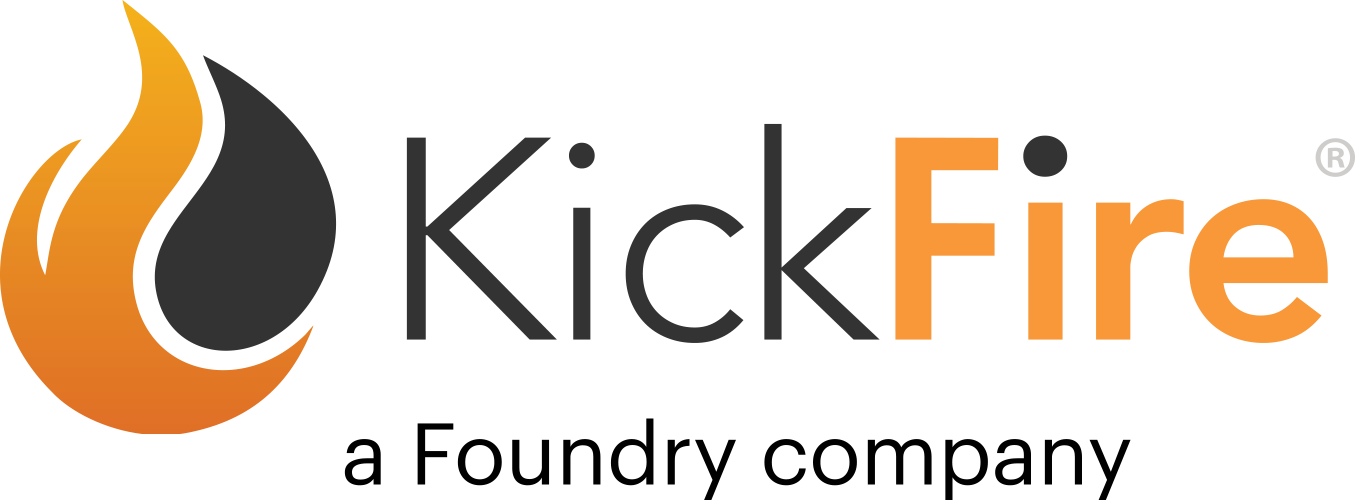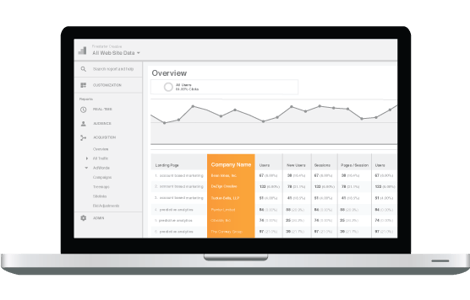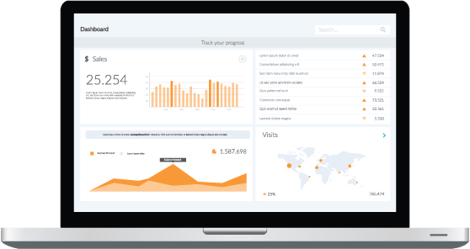Intent Data for Google® Analytics
KickFire integrates into Google Analytics
See how it works
Connect account-level data to Google Marketing Platform
|
Identify and engage your in-market buyers
|
Learn More
Read Our Guide
3 Steps to Reduce Ad Waste in Google Analytics & Ads
Google Analytics and Google Ads are two powerful tools marketers have been using for years to gain insight into their website traffic and generate new leads. However, traditionally these platforms have been geared toward B2C marketers.
Google Analytics focuses on metrics such as the total number of sessions, impressions, clicks, conversions, that are pertinent to mass marketing strategies but are severely lacking in meaningful metrics for account-based marketing. This has left B2B marketers with limited behavioral data in Google Analytics and lacking any in-depth knowledge about the actual companies behind these engagement metrics.
In addition, in Google Ads, marketers have had limited or no way to monitor exactly which companies were served their ads. This lack of information has led to a significant increase in ads being served to unqualified buyers and the inability to validate the efficacy of marketing campaigns.
In this guide, we will explain how to connect account-level data into Google’s Analytics and Ads platforms to serve remarketing ads to search users based on company attributes (such as industry, revenue, and employee count) and turn this once B2C focused platform into a B2B marketing powerhouse.
Step 1: Incorporate Company Data Into Google Analytics and Ads
The first step in the path to reducing ad waste is connecting KickFire’s account-level data directly into the Google Analytics platform. Here is what a typical Google Analytics report looks like without KickFire data: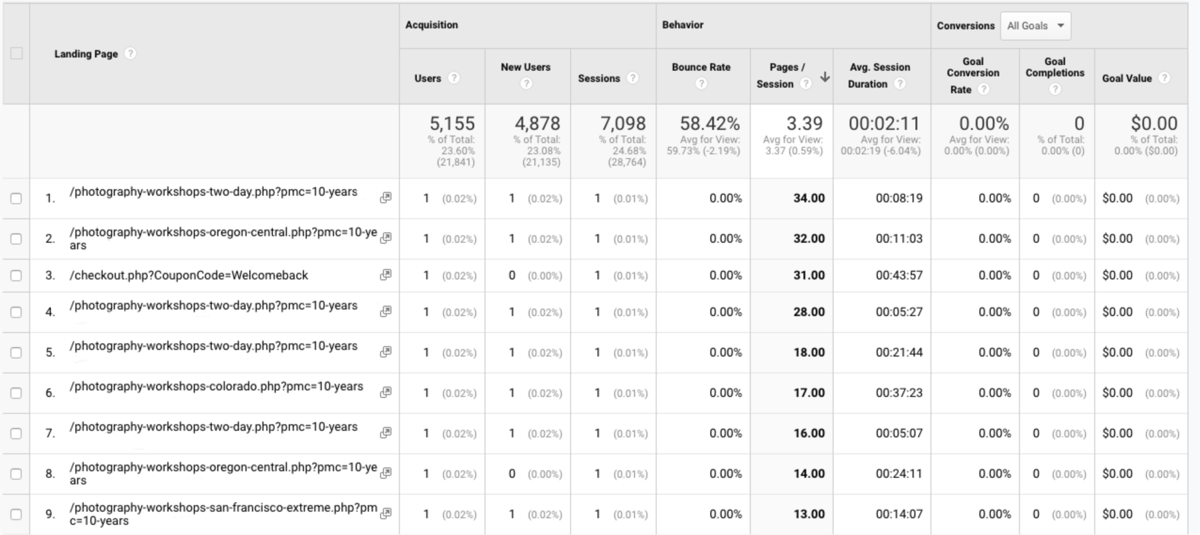
Does this dashboard look familiar? A report like this might still be useful for B2C marketers, however B2B marketers put a great deal more effort into targeting high-value accounts, and as such are more focused on qualitative metrics. Total number of pageviews is good, but for B2B marketers, it would be more useful to know exactly which company was viewing these pages.
Now here is the same report enhanced with KickFire’s company data:
Reports like this provide a tremendous difference in the amount of insights marketers can gain from Google Analytics.
This same comparison can be made for traditional Google Ads reporting. Looking at a breakdown of the companies visiting a website can not only provide better campaign attribution, but can also be used to discover potential untapped market segments, as well as allow for more focused targeting and remarketing efforts.
Again, seeing the total number of clicks and impressions can be a good indicator of whether or not a campaign is working in a general sense, but from a B2B marketer's standpoint, these metrics lack any real data needed to gather meaningful insights into an account-based marketing (ABM) campaign’s success.
From this company data it is much easier to answer many of the most crucial questions B2B marketers have when running an ad campaign: Which campaigns are driving high-value audiences? Which companies should be considered “high-value?” Which companies are seeing and engaging with my ads?
Step 2: Build Custom Audiences
Now that company data is connected into Google, the next step is to build custom audiences and leverage company data to reengage accounts that have visited your website but left without converting.
Traditionally within Google Ads, remarketing is behavior-based, meaning a website visitor is only placed into a remarketing audience once they have completed a specified action on a company’s website such as viewing a product pricing page or reaching checkout.
However, with the addition of company data into Google, B2B marketers now have the power to build custom remarketing audience segments based on company attributes such as industry, location, revenue, etc. – making it much easier to build effective remarketing lists.
For example: If you want to target only hospitals in the U.S. with a revenue of $1 billion or more, you can simply build an audience based on those company attributes.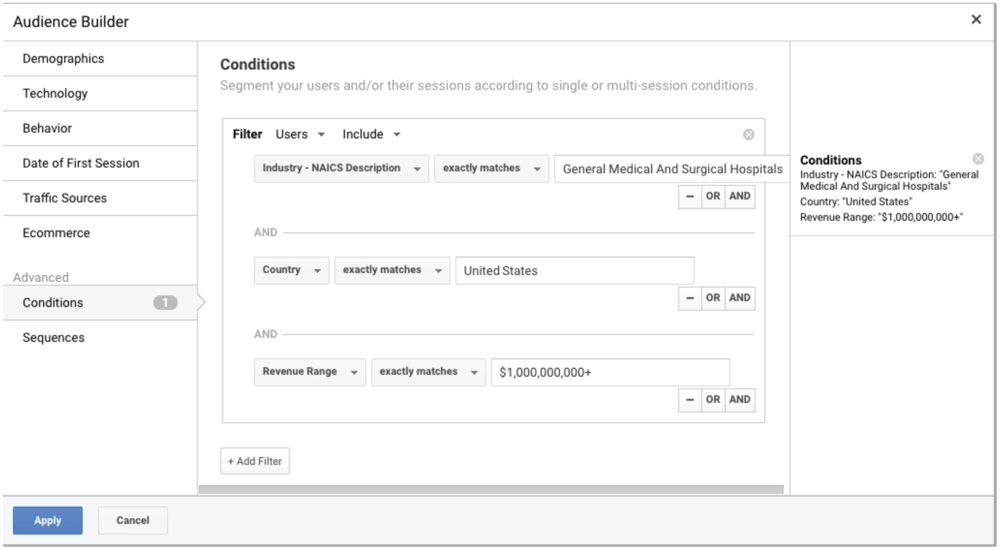
However, the goal here is to have the best of both worlds – casting as wide a net as possible to get the most impressions but being certain that the accounts seeing the ads are actually in-market to purchase.
Step 3: Remarket to Custom Audiences
Once the target audience built in Google, it’s time to advertise to them. Traditional keyword-based search ads can be one of the most effective ways to get more clicks and drive more traffic, but it can also be one of the most expensive with little return if done incorrectly. If you’re only targeting broad match keywords (i.e. a broad range of possible keywords that Google thinks are related to your main search term), sure, you’ll likely see a significant amount of impressions and possibly even clicks, but very low conversion rates. You’ll also find out very quickly just how creative Google can be at spending your ad budget.
On the other hand, as you get more and more specific with the keywords you’re targeting, you drastically decrease the amount of search traffic, but increase the likelihood that the user will actually be in the market for your product or service.
To utilize broad matching and eliminate ad waste, marketers have two options: Targeting and Observation.
Targeting will only show ads to companies that fit within the audience criteria you have set up – that’s it, no magic, no gimmicks, it’s really just that simple.
Exclusion Lists: Think of this as the exact opposite of a target audience list – these are the accounts you do not want to market to. This list can include competitors, unqualified buyers, single session bouncers, people at your own company, and more. By utilizing the exclusion feature, you essentially “blacklist” any of these companies from ever seeing your ad in the first place. This will ensure that your ads will only be shown to the right people and prevent you from spending money advertising to the wrong ones as well.
Observation takes Targeting to the next level. An Observation ad campaign allows marketers to increase their maximum cost per click based on the user’s audience list. This is an incredibly powerful method with a much higher probability of securing an ad placement for high-value audiences. This type of campaign is best used to win an extremely high-value ad placement (for example, an ad seen by a company that is currently in your sales pipeline).
To illustrate how a “Targeting” broad match ad campaign works, let’s look at an example.
Imagine your company sells enterprise-level project management software. The average deal price is $50,000, and you want to run a paid search campaign to drive sales.
A traditional broad match campaign on the keyword “project management software” might cost $20 per click. A budget of $12,000 would net 10,000 impressions, 600 clicks, zero conversions, and resulting in zero dollars of revenue. Why? Because you’re advertising the right product to the wrong people.
Yes, the large amount of people searching for “project management software” could potentially be in the market for your solutions, but with an average price tag of $50,000, your products simply aren’t right for everyone. Only a small segment of companies will be willing to pay that price or even be large enough to utilize an enterprise-level solution.
But what if you could make sure that your ads were only shown to companies with an annual revenue of $500 million or more, and a company size of at least 500 employees?
For the same $12,000, you might only be able to serve 2,000 ad impressions to this audience because it is much smaller and more defined, but much more likely to be in the market for software. Suddenly those 2,000 impressions might turn into 250 clicks and 10 conversions – giving you a cost per click of $48 but resulting in $500,000 in revenue.
Now this is just one example, but the general idea can be applied almost universally – knowing exactly who you’re advertising to will not only prevent you from wasting your ad budget, but will also allow for much more targeted messaging that is more likely to convert potential buyers.
Here’s how all of these elements work together:
- Someone from Company X visits your website.
- As soon as they land on your site, KickFire identifies the company and provides valuable account data such as industry, revenue, etc.
- This data is connected directly to Google Analytics reporting as well as remarketing audiences in Google Ads.
- If Company X’s attributes match a custom audience, they are added to a remarketing campaign.
- When someone from Company X searches for a term related to your broad match keyword, you bid higher on this ad placement knowing that the person seeing the ad is coming from your target audience and searching for something related to your product.
- Because you’ve increased your bid, your ad is served in the top position. The user clicks the ad, returns to your website, and converts.
As B2B marketers, we’re living in exciting times. We have unprecedented access to information our predecessors could only dream about, so it seems only fair that we take advantage of as much data as we can. Leveraging KickFire’s company identification technology and firmographic data will not only provide enhanced insights into your website traffic but will also empower you to advertise more efficiently in the Google Marketing Platform. Together we can eliminate ad waste and deliver the best messaging to the right accounts at the right time. Visit KickFire.com to start your free trial and see the power of account-level data in Google Marketing Platform.
